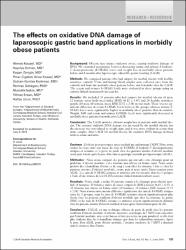The effects on oxidative DNA damage of laparoscopic gastric band applications in morbidly obese patients

View/
Access
info:eu-repo/semantics/openAccessDate
2014Author
Kocael, AhmetErman, Hayriye
Zengin, Kagan
Kocael, Pınar Çiğdem Arica
Korkmaz, Gülcan Güntaş
Gelisgen, Remise
Uzun, Hafize
Metadata
Show full item recordAbstract
Background: Obesity may induce oxidative stress, causing oxidative damage of DNA. We examined associations between decreasing serum and urinary 8-hydroxy-2'-deoxyguanosine (8-OHdG) levels and weight loss in morbidly obese patients before and 6 months after laparoscopic adjustable gastric banding (LAGB). Methods: We compared patients who had surgery for morbid obesity with healthy, nonobese controls. Urine and fasting blood samples were collected once from the controls and from the morbidly obese patients before and 6 months after the LAGB. The serum and urinary 8-OHdG levels were evaluated in these groups using an enzyme-linked immunosorbent assay kit. Results: We included 20 patients who had surgery for morbid obesity (8 men, 12 women, mean body mass index [BMI] 46.82 +/- 4.47) and 20 healthy, nonobese people (10 men, 10 women, mean BMI 22.52 +/- 2.08) in our study. There was no significant difference in serum 8-OHdG levels between the groups, whereas urinary 8-OHdG levels were significantly higher in morbidly obese patients than in controls. Weight, BMI and serum and urinary 8-OHdG levels were significantly decreased in morbidly obese patients 6 months after LAGB. Conclusion: The LAGB provides efficient weight loss in patients with morbid obesity. The systemic oxidative DNA damage was increased by the morbid obesity, but this increase was not related to weight gain, and it was more evident in serum than urine samples. After LAGB for morbid obesity, the oxidative DNA damage declined both in serum and urine.


















